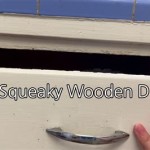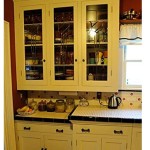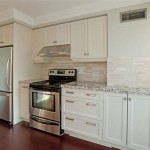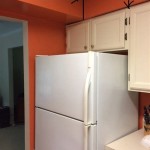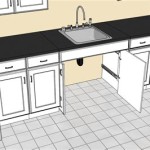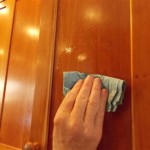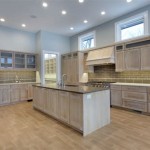Concrete Kitchen Cabinets in Singapore: A Durable and Modern Choice
Singapore's urban landscape is constantly evolving, and with it, the design aesthetics of its homes. Kitchens, as the heart of the home, are no exception. Concrete kitchen cabinets are increasingly becoming a popular choice for homeowners seeking a modern, durable, and minimalist aesthetic. This article explores the appeal of concrete kitchen cabinets in Singapore, delving into their advantages, disadvantages, design considerations, maintenance requirements, and cost implications.
Concrete, a composite material made of cement, aggregates, and water, offers a unique texture and visual weight that complements contemporary interior design trends. Its inherent strength and versatility allow for the creation of custom cabinets that can be tailored to specific kitchen layouts and design preferences. The industrial chic aesthetic that concrete embodies resonates with many Singaporean homeowners looking to create a sophisticated and functional kitchen space.
Durability and Longevity
One of the primary reasons for the growing popularity of concrete kitchen cabinets is their exceptional durability. Unlike wood or laminate cabinets, concrete is resistant to moisture, heat, and scratches, making it ideal for the harsh conditions often found in Singaporean kitchens. The tropical climate, characterized by high humidity and temperature fluctuations, can accelerate the deterioration of traditional cabinet materials. Concrete, however, stands up remarkably well to these environmental factors.
The inherent strength of concrete also translates to a longer lifespan. Well-constructed and properly sealed concrete cabinets can last for decades, minimizing the need for frequent replacements. This longevity provides a significant return on investment, especially considering the high costs associated with kitchen renovations in Singapore. The robust nature of concrete ensures that cabinets maintain their structural integrity and aesthetic appeal over time, resisting wear and tear from daily use.
Furthermore, concrete is inherently fire-resistant, providing an added layer of safety to the kitchen. This is a crucial consideration for many homeowners, particularly those living in high-rise apartments where fire safety is paramount. The non-combustible nature of concrete helps to contain fires and prevent them from spreading rapidly, protecting both property and lives.
The durability of concrete isn't just about resisting physical damage; it also extends to its resistance to pests and mold. Unlike wood, concrete doesn't provide a food source for termites or other wood-boring insects. Its non-porous surface, when properly sealed, also prevents the growth of mold and mildew, which are common problems in humid environments. This resistance to pests and mold contributes to a healthier and more hygienic kitchen environment.
Design Versatility and Customization
While often associated with a stark, industrial look, concrete is surprisingly versatile in its design possibilities. It can be molded into various shapes and sizes, allowing for the creation of custom cabinets that perfectly fit any kitchen layout. From sleek and minimalist designs to more elaborate and textured finishes, concrete can be tailored to suit a wide range of aesthetic preferences.
Color can also be incorporated into concrete kitchen cabinets through the addition of pigments during the mixing process. This allows homeowners to choose from a vast spectrum of colors, ranging from subtle greys and beiges to bold and vibrant hues. Stains and dyes can also be applied to the surface of the concrete to create unique and personalized finishes. The ability to customize the color and finish of concrete cabinets ensures that they seamlessly integrate with the overall design scheme of the kitchen.
In addition to color and finish, concrete can also be textured to create visual interest. This can be achieved through various techniques, such as adding aggregates to the mix, texturing the surface during the curing process, or applying textured coatings after the concrete has hardened. The use of textures can add depth and dimension to the cabinets, creating a more tactile and engaging design.
The ability to integrate hardware seamlessly into concrete cabinets is another testament to their design versatility. Handles, knobs, and pulls can be recessed into the concrete, creating a flush and minimalist look. Alternatively, they can be mounted on the surface of the concrete, providing a contrasting element that enhances the overall design. The integration of hardware allows homeowners to personalize their concrete cabinets and create a kitchen that truly reflects their individual style.
Maintenance and Upkeep
While concrete is a durable material, it does require some maintenance to keep it looking its best. Proper sealing is crucial to protect the surface of the concrete from stains and moisture. Sealants penetrate the pores of the concrete, creating a protective barrier that prevents liquids from seeping in. Regular resealing, typically every few years, is necessary to maintain the effectiveness of the sealant.
Daily cleaning of concrete kitchen cabinets is relatively simple. A mild soap and water solution is usually sufficient for removing spills and stains. Abrasive cleaners should be avoided, as they can scratch or damage the surface of the concrete. It is also important to wipe up spills promptly to prevent them from setting in and staining the concrete.
While concrete is resistant to heat, it is still advisable to use trivets or hot pads when placing hot pots and pans on concrete countertops to prevent thermal shock. Rapid temperature changes can cause the concrete to crack or chip, particularly if it is not properly sealed. Taking these precautions will help to prolong the lifespan of concrete kitchen cabinets.
Staining can be a concern with concrete, especially if the sealant is compromised or if highly pigmented liquids are spilled on the surface. While stains can be difficult to remove, there are specialized cleaning products available that can help to lift them. It is important to test these products in an inconspicuous area first to ensure that they do not damage the concrete. In some cases, it may be necessary to reapply the sealant to restore the protective barrier.
Cost Considerations
The cost of concrete kitchen cabinets in Singapore can vary depending on several factors, including the size and complexity of the design, the type of concrete used, the finish applied, and the installation costs. Generally, concrete cabinets are more expensive than traditional wood or laminate cabinets, primarily due to the specialized materials and labor required for their construction.
The type of concrete used can significantly impact the cost. High-performance concrete, which is stronger and more durable, will typically cost more than standard concrete. The addition of pigments, aggregates, or other additives can also increase the cost of the concrete. The finish applied to the concrete, such as polishing, staining, or sealing, will also contribute to the overall cost.
Installation costs can also vary depending on the complexity of the project. Custom-designed cabinets that require precise measurements and intricate detailing will typically be more expensive to install than standard-sized cabinets. The expertise of the installer is also a factor. Experienced installers who are familiar with working with concrete will generally charge more than less experienced installers.
Despite the higher initial cost, concrete kitchen cabinets can be a worthwhile investment in the long run. Their durability and longevity minimize the need for frequent replacements, saving homeowners money over time. The low maintenance requirements of concrete cabinets also translate to cost savings, as they require less upkeep than traditional cabinet materials.
Homeowners considering concrete kitchen cabinets in Singapore should obtain multiple quotes from reputable contractors to compare pricing and ensure that they are getting the best value for their money. It is also important to factor in the long-term benefits of concrete cabinets, such as their durability, low maintenance, and aesthetic appeal, when making a purchasing decision.

Advantages Of Concrete As A Kitchen Countertop Material

Kitchen Concrete Basin La Maison Carpentry

Kitchen Cabinet Renovation Construction And Replacement Repair Of Cement Concrete Mortar Tiles Countertop Sink Support Tabletop For Toilet Erection Wall Home Services Renovations Flooring Vinyl

Custom Kitchen Cabinets Singapore S Most Affordable Picket Rail Furniture Interiors

Kitchen Concrete Basin La Maison Carpentry

Custom Kitchen Cabinets Singapore S Most Affordable Picket Rail Furniture Interiors

Kitchen Tiling Singapore Complete Guide With 2024 Costing

Custom Kitchen Cabinets Singapore S Most Affordable Picket Rail Furniture Interiors

Types Of Kitchen Cabinet Design And How To Pick The Right One

Enter Min Poh Collin S Dreamy Industrial Loft Walk Up Outdoor Kitchen Design Home Kitchens Minimalist Living Room
Related Posts

